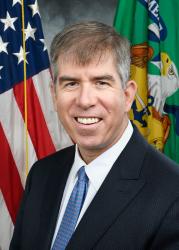Over a decade after the start of the Great Recession, most Americans looking for a job can find one—the unemployment rate has fallen to around 3.9 percent. Also, following a decline in labor force participation that pre-dated but continued through the Great Recession, the share of Americans aged 25-54 in the labor market has increased in the last few years.
Despite these positive developments, the labor market is not perfect. Wage growth is still sluggish, with modest gains offset by inflation. Despite recent increases, the share of prime-age Americans in the labor force is still slightly below the pre-Recession level. Levels of unemployment vary widely across places and the population by key demographic characteristics.
In August of last year, The Hamilton Project calculated that the “jobs gap”—the difference between demographically adjusted national employment and its level before the recession—had closed for the country overall. That is, after adjusting for demographic shifts, the economy had added enough jobs to fill the hole left by the Great Recession.
But not every group of Americans has fully recovered from the Great Recession. In this piece, we provide an annual update of the employment rate gap, which is different from the jobs gap, by race/ethnicity and level of education.
Calculating employment rate gaps
Using the Current Population Survey from January 2007 to May 2018, we identify the “employment rate gap:” the difference between the demographically adjusted 2007 employment-to-population ratio and the actual employment-to-population ratio at a given point in time. It should be noted that this methodology differs from that used for The Hamilton Project’s previous monthly jobs gap series.1 Because we are exploring differential trends by demographic characteristics, we cannot use payroll employment from the Current Employment Statistics, as the “jobs gap” did.
Recovering from the Great Recession
Figure 1 shows that, in the depths of the Great Recession, blacks and Hispanics faced much steeper job losses than their white counterparts. What this figure also shows, though, is that blacks and Hispanics recovered from the recession much more quickly, and ultimately closed their employment rate gap before non-Hispanic whites did. Once we account for demographic change, the employment-to-population ratio for blacks is almost two percentage points above pre-recession levels.

That said, we note that even with this higher rate of growth for blacks, they still experience lower levels of employment in absolute terms. In June 2018, 58.2 percent of African-Americans aged 16 and older were employed, compared to 60.6 percent of whites and 63.4 percent of Hispanics, and the unemployment rate for African-Americans was still nearly twice the rate it is for white Americans.
All three major ethnic groups have a demographically adjusted employment rate above the pre-crisis level, consistent with the demographically adjusted jobs gap having closed.
There are three reasons this may not signal an end to slack in the economy. First, as Americans live longer and the Social Security retirement age has increased, older Americans are working longer. The employment rate for 55-64 Americans is well above pre-recession levels while the prime age employment rate is still slightly below its November 2007 level. Second, as noted in Schanzenbach, Nunn, Bauer, and Breitwieser, the employment recovery from the 2001 recession was weak—arguably leaving labor market slack in 2007—such that recovering to the 2007 level may not mark the elimination of labor market weakness. Finally, given that more-educated Americans tend to have higher employment levels, one might have expected the increase in educational attainment from 2007 to 2018 to have raised the employment-to-population ratio. We therefore explore educational outcomes next.

Those with less education were disproportionately harmed by the Great Recession (figure 2).2 We see that graduate degree holders—and to a lesser extent bachelor’s degree holders—experienced smaller reductions in employment during the recession. For those with no postsecondary degree, the employment rate gap in 2011 was 5 percent or more, while it was just 2 percent for those with a bachelor’s degree.
Recovery from the bottom of the trough occurred earlier for those with more education. The first upturn among graduate degree holders was between 2009 and 2010, between 2010 and 2011 for those with a bachelor’s degree. By 2018, only those with bachelor’s or graduate degrees had returned to their demographically adjusted pre-recession employment rate.
The recession was particularly hard on those without a high school diploma. In 2010 and 2011, this group had an employment-to-population ratio that was fully six percentage points lower than in 2007. Those with a high school diploma and/or some college followed a similar trend through this period, with a slightly shallower trough during the worst of the recession than those who didn’t graduate from high school. In recent years, workers without a postsecondary degree have seen improving employment outcomes, though a gap remains.3
Not only have less-educated groups not recovered as fully from the recession, they started at lower levels of employment rates prior to the crisis such that at this point, amongst those aged 25 and higher, 72.5 percent of those with a bachelor’s degree work compared to just 55 percent of those with only a high school degree.
Conclusion
The Great Recession inflicted economic pain on many American families, but its burden was not equally distributed. Ultimately, the brunt of the Great Recession was borne by those without the protection of postsecondary education. College raises average lifetime earnings, and it also helps insulate workers from economic downturns, providing economic security in the times they need it most. Finally, racial disparities have been less severe in recovery than in the worst years of the Great Recession, though differences in employment rates persist. For the American labor market to be truly healthy, it needs to work for all people—not just some.






Commentary
Workers with low levels of education still haven’t recovered from the Great Recession
September 6, 2018